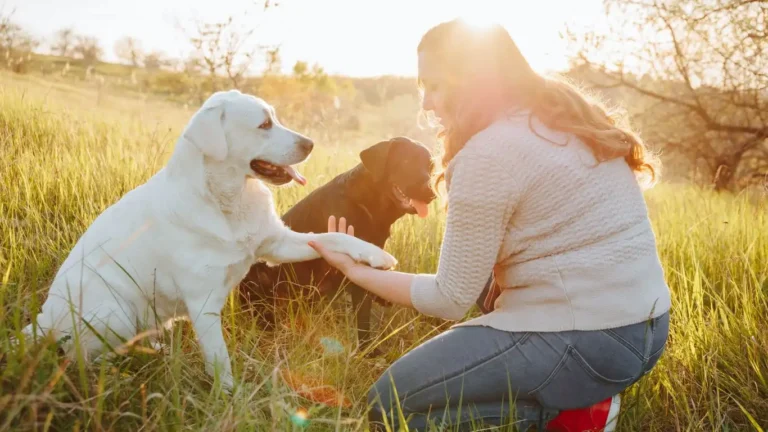Signs Your Dog Is in Pain: How to Tell and What to Do
Have you ever looked at your dog and thought, "Something’s off, but I can’t quite put my finger on it?" As a pet nutritionist and pet care expert working in veterinary clinics, I’ve seen countless pet parents struggle with recognizing discomfort in their furry companions. How to tell if a dog is experiencing pain isn’t always as straightforward as a limp or a whimper—it can be subtle, hidden, or even completely silent. Our dogs are wired to mask pain, an instinct carried over from their wild ancestors. That’s why understanding the telltale signs is crucial.
Contents showWhy Dogs Hide Their Pain

Dogs have an innate survival instinct that tells them to hide pain. In the wild, showing weakness could make them an easy target for predators. Even though our pups are safe in their cozy homes, this instinct still lingers. As a result, by the time a pet parent notices something is wrong, the issue might have been brewing for a while.
Common Reasons a Dog May Be in Pain
Pain in dogs isn’t just from injuries. There are several causes, some obvious, others not so much:
- Injuries: Sprains, fractures, or wounds from rough play or accidents.
- Arthritis: Just like us, dogs experience joint pain as they age.
- Dental Problems: Toothaches can cause serious discomfort, but dogs rarely show it.
- Internal Issues: Organ pain from conditions like pancreatitis, kidney disease, or gastrointestinal problems.
- Ear Infections: These can be incredibly painful and often go unnoticed until they’re severe.
Subtle Signs Your Dog Might Be in Pain

Not all dogs will cry or limp when they’re hurting. In fact, most won’t. Instead, they show signs in ways that might not seem obvious at first. Here are some key behavioral and physical changes to watch for:
1. Changes in Activity Levels
One of the first things I ask pet parents when they suspect something’s wrong is: “Has your dog been less active lately?” A normally playful pup that suddenly prefers lounging in a corner might be trying to tell you something. Less enthusiasm for walks, reluctance to jump, or hesitation to climb stairs can indicate joint or muscle pain.
2. Unusual Postures or Stiffness
Have you ever seen your dog moving a little stiffly when getting up? Maybe they arch their back or tuck their tail more than usual. These subtle changes can be signs of discomfort. I had a Labrador patient once whose parents thought he was just "getting old," but a closer look revealed early signs of hip dysplasia.
3. Appetite Changes
If your pup suddenly turns their nose up at their favorite meal, don’t just assume they’re being picky. Pain, especially dental pain or internal discomfort, can cause a dog to eat less or avoid chewing on one side of their mouth. If your dog is usually food-driven but starts skipping meals, it’s worth a vet visit.
4. Excessive Licking or Chewing
Dogs instinctively lick areas that hurt. Constantly licking paws, joints, or a specific spot on their body might be their way of soothing pain. I’ve seen dogs with hidden joint issues that obsessively licked their elbows, leading to raw spots. If your dog is fixated on a particular area, investigate further.
When to See a Vet

Some mild discomfort can be managed at home, but certain signs warrant an immediate trip to the vet:
- Persistent or worsening limping
- Whimpering, yelping, or sudden aggression when touched
- Complete loss of appetite for more than a day
- Severe lethargy or difficulty standing
- Bloated abdomen (could indicate a serious emergency like bloat or internal bleeding)
Trust your gut—if something feels off, don’t wait. I always tell pet parents, “You know your dog better than anyone else.” Subtle changes can be the first clues that something isn’t right.
Behavioral Changes That Signal Pain

Dogs aren’t always vocal about their pain. In fact, most of them prefer to suffer in silence, relying on subtle behavioral changes to communicate distress. I’ve had pet parents come in saying their dog has been acting “weird,” but they couldn’t pinpoint why. More often than not, pain was the hidden culprit.
1. Increased Irritability or Aggression
Even the sweetest, most gentle pup can get snappy when they’re in pain. If your usually friendly dog suddenly growls or snaps when you touch a certain spot, it’s a huge red flag. I remember a Golden Retriever who had always been a social butterfly—until one day, he started avoiding affection and growling when petted. Turns out, he had undiagnosed hip dysplasia that had been worsening over time.
2. Sudden Clinginess or Avoidance
Some dogs become extra needy when they’re hurting, seeking comfort from their humans. Others go the opposite route, withdrawing and hiding. If your dog is acting out of character—following you everywhere or isolating themselves—it might be worth a closer look.
3. Restlessness and Pacing
Pain makes it hard to get comfortable. If your dog keeps shifting positions, pacing around the house, or lying down only to get back up again, they could be struggling with internal discomfort or joint pain. This was exactly what a senior Beagle I worked with experienced—his arthritis made it nearly impossible to settle into a comfortable sleeping position.
4. Whining, Whimpering, or Heavy Panting
While some dogs suffer silently, others vocalize their discomfort through whining or whimpering, especially when moving or being touched. Excessive panting when it’s not hot out is another common indicator of pain—almost like their body is trying to cope with the discomfort.
Physical Signs of Pain in Dogs

Sometimes, pain shows up in physical ways that go beyond just limping. These signs might not be as obvious at first glance, but once you know what to look for, they become much easier to spot.
1. Changes in Posture
A dog in pain may hold their body differently than usual. Some common postural changes include:
- Arched back: Often seen in dogs with abdominal pain.
- Tucked tail: A protective stance when experiencing pain.
- Stiff movements: Seen in dogs with joint or muscle discomfort.
One of my patients, a playful Husky, suddenly started hunching her back slightly. Her owners thought it was a behavioral quirk, but after a thorough check-up, we discovered she had early-stage spinal issues.
2. Facial Expressions That Indicate Pain
Believe it or not, a dog’s face can tell you a lot about how they’re feeling. Pay attention to these cues:
- Glazed or unfocused eyes
- Pinned-back ears
- Furrowed brow or tense jaw
Next time your dog is acting off, take a close look at their expression—it might be trying to tell you something.
3. Limping or Favoring One Side
Limping is one of the more obvious signs of pain, but don’t just focus on dramatic limps. Sometimes, dogs subtly shift their weight off one leg or walk with a slightly uneven gait. If you notice your pup hesitating before jumping or climbing stairs, it could be an early sign of pain.
4. Shaking or Trembling
Shivering isn’t just a sign of cold—it can also indicate pain. I once had a small Terrier patient who came in trembling constantly. At first, we thought it was anxiety, but it turned out she had severe dental pain from an infected tooth. Once treated, the shaking stopped completely.
How to Comfort a Dog in Pain

Once you suspect your dog is in pain, the next question is—what can you do to help? While veterinary care is always the best option, there are a few ways to provide comfort in the meantime.
1. Provide a Quiet, Cozy Space
A dog in pain often seeks out a safe, comfortable spot to rest. Help them by creating a quiet, cushioned area away from loud noises or foot traffic.
2. Gentle Massage and Warm Compresses
If your pup has muscle soreness or arthritis, gentle massages or a warm compress on the affected area can provide relief. Just be careful—if your dog pulls away or flinches, stop immediately.
3. Use Soft, Supportive Bedding
Hard surfaces can make joint pain worse. Orthopedic beds, memory foam cushions, or even extra blankets can make a world of difference for a dog dealing with chronic pain.
4. Keep Them Hydrated and Comfortable
Dogs in pain may not feel like getting up to drink, so make sure their water is easily accessible. Dehydration can make pain symptoms worse, so encourage small, frequent sips.
Recognizing and responding to pain in dogs is crucial for their well-being. The more we tune in to their subtle cues, the better we can support them in leading happy, healthy lives. In the next section, we’ll dive into professional treatments, pain management strategies, and what vets recommend for different conditions.
Veterinary Treatments for Pain Management

So, you’ve noticed the signs, and now you’re wondering: what’s next? The best course of action is always to consult a veterinarian. I can’t tell you how many times pet parents have delayed vet visits because they thought their dog’s discomfort would “just go away.” Unfortunately, untreated pain can worsen over time, leading to chronic issues.
1. Prescription Pain Medications
Depending on the diagnosis, your vet may prescribe medications to manage your dog’s pain. Common options include:
- NSAIDs (Non-Steroidal Anti-Inflammatory Drugs): These help reduce pain and inflammation but should only be given under veterinary supervision. Examples include carprofen and meloxicam.
- Opioids: Used for more severe pain, often post-surgery or for chronic conditions like cancer.
- Gabapentin: A go-to for nerve-related pain and often used for senior dogs with arthritis.
- Joint Supplements: While not painkillers, supplements like glucosamine and chondroitin support joint health and reduce discomfort over time.
Important Note: Never give your dog human pain relievers like ibuprofen or acetaminophen—they can be toxic!
2. Physical Therapy and Rehabilitation
One of the best treatments I’ve seen work wonders is physical therapy. Hydrotherapy (underwater treadmill sessions), laser therapy, and targeted exercises can significantly improve mobility and reduce pain, especially in arthritic or post-injury dogs.
3. Acupuncture and Alternative Therapies
Yes, you read that right—acupuncture for dogs! It might sound unusual, but I’ve personally seen dogs respond remarkably well to acupuncture for pain relief. Along with chiropractic care and massage therapy, these treatments can be excellent complementary options.
Home Remedies and Lifestyle Adjustments

While veterinary treatments are essential, there are also simple things you can do at home to make your dog more comfortable.
1. Maintain a Healthy Weight
Extra weight means extra stress on joints and muscles. If your dog is overweight, a vet-approved diet plan can help relieve pressure on their body, especially if they suffer from arthritis or hip dysplasia.
2. Gentle Exercise
It might seem counterintuitive, but controlled, low-impact exercise can help dogs stay mobile and reduce stiffness. Swimming, short walks, and stretching exercises are great options.
3. Provide an Orthopedic Bed
Hard floors can make pain worse, especially for older dogs. Investing in an orthopedic or memory foam dog bed can make a significant difference in their comfort.
4. Heat Therapy
A warm compress applied to sore joints can work wonders. However, make sure it’s not too hot—always test it on your own skin first.
5. Supplements and Anti-Inflammatory Foods
Certain foods can naturally help reduce inflammation. Consider incorporating:
- Fish oil: Packed with omega-3 fatty acids, great for joint health.
- Turmeric: A natural anti-inflammatory (but always consult your vet for proper dosage).
- Bone broth: Supports joint and gut health.
Preventing Pain: How to Keep Your Dog Comfortable Long-Term
Prevention is always better than treatment. While some health issues are unavoidable, there are proactive steps you can take to minimize pain risks.
1. Regular Vet Check-Ups
Routine check-ups can catch potential issues before they escalate. A yearly vet visit (or biannual for senior dogs) ensures early detection of conditions like arthritis, dental disease, or internal issues.
2. Monitor and Adjust Their Diet
A well-balanced, species-appropriate diet plays a massive role in keeping joints, muscles, and organs healthy. As a pet nutritionist, I always emphasize the importance of high-quality ingredients—what goes into your dog’s bowl directly affects their well-being.
3. Keep an Eye on Dental Health
Dental disease is one of the most overlooked causes of pain in dogs. Regular brushing, dental chews, and professional cleanings can prevent painful infections.
4. Modify Their Environment
Make daily activities easier by adding ramps for furniture or the car, using non-slip rugs on slippery floors, and ensuring their food and water bowls are at a comfortable height.
Final Thoughts
Recognizing and addressing pain in dogs isn’t always straightforward, but as responsible pet parents, it’s our job to stay vigilant. Our furry companions rely on us to notice the small changes, interpret their silent signals, and advocate for their well-being.
Whether it’s through veterinary care, home adjustments, or lifestyle changes, there are plenty of ways to help your dog live a happier, pain-free life. Always trust your instincts—if something seems off, don’t wait to seek professional advice.
References
Disclaimer
This article is for informational purposes only and is not a substitute for professional veterinary advice. If you suspect your dog is in pain, consult a veterinarian immediately.






